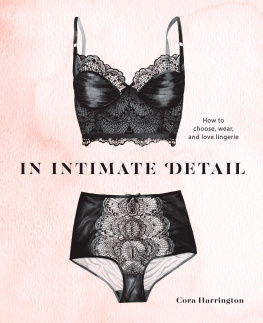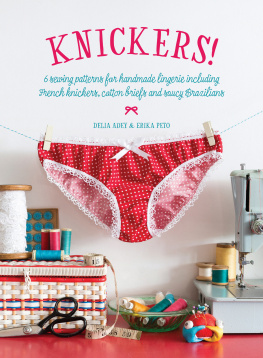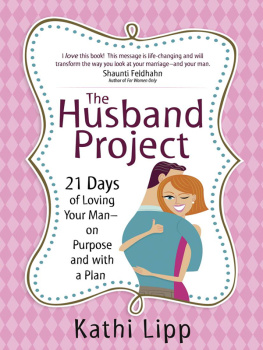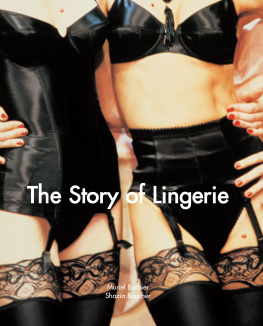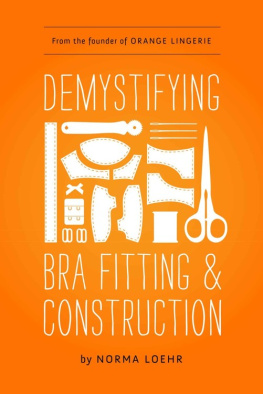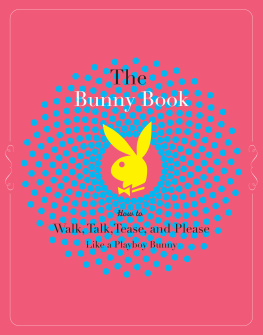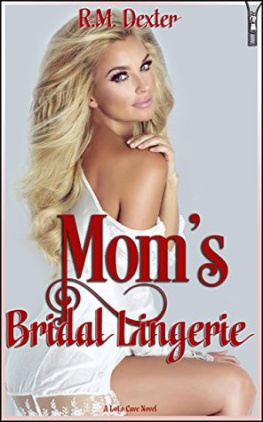Contents
CORA HARRINGTON is the founder and editor in chief of The Lingerie Addict, the worlds leading lingerie blog dedicated to the fashion of intimate apparel. Recognized as one of the foremost authorities on the lingerie industry and lingerie trends, Cora believes lingerie is something everyone can appreciate and enjoy, and her passion is helping people find the perfect lingerie. This is her first book.
APPENDIX A
Special Bra-Fitting Concerns
Chapter 1 covered the basics of bra fitting, but if you have a special fit or body concern, this appendix is for you.
Plus Size
You may find that you need to size down from your underbust measurements for an ideal fit. There are two reasons for this. One, you may have more squish around your rib cage. This means that your band will need to be a little tighter to anchor properly and also that you may be able to tolerate a tighter band (and therefore a more secure fit) than someone whose bra band rests directly on the bones of the rib cage. Two, bra bands, especially in modern-day bras, are stretchy. The longer the band (that is, the larger the band size), the more stretchy the band is. This is due to a quirk of elastic fabrics; essentially, more stretch fabric equals more stretch. If you are plus-sized and small busted, you likely wear a hard-to-find size. Sister sizing down one band size and up one cup size (and then using a bra band extender, if applicable) may offer a wider range of fashionable options.
Trans Women & Nonbinary People
If you are transitioning or getting ready to buy your first bra, it can be a daunting step. While you might be just fine going braless for a while, many transitioning people find they need bras once their nipples become more visible and projected or once they have enough breast tissue to bounce while running or going up and down stairs. Even if youre not developing breasts at the moment or have no interest in hormone replacement therapy (HRT) or mammoplasty, bras can help with gender dysphoria.
As with all bra-fitting methods, youll need to know your measurements. While some experts recommend going with your exact rib-cage measure for the bra band, if youre transitioning from an Assigned Male at Birth body (AMAB), youll almost certainly want to size up by two or even four inches (or potentially more, depending on your body shape and comfort level). This is especially true at first, as bras can take time to get used to. If you have a wider rib cage, perhaps with more muscle and less squish, a larger size can help you avoid any discomfort from the bra band digging into your ribs. If you dont yet have a lot of breast tissue to support, the band is also doing less work, which means it doesnt need to fit as snugly.
Contour cup plunge bras and bras with push-up style padding can help shape and project the bust and also makes it easier to add optional bra pads or inserts (also known as cookies ). However, if thats not comfortable for you (or if youd rather wear a bra without padding), bralettes are a good choice. Because bralettes tend to come in small, medium, and large sizes instead of cup and band sizes, and because they have unstructured cups, bralettes can be more size-flexible as well as more accommodating to a developing bust.
Last, if you have just started HRT, avoid running out and buying a lot of bras right away. Your bra size will likely change often in the next few weeks to months, and you may experience some pain and sensitivity as well. If thats the case, look for bras with soft interior linings to avoid irritation.
Mastectomy/Post-Surgery
A mastectomy bra is designed specifically for people who have undergone mastectomies (the surgical removal of one or both breasts). While many mastectomy bras have pockets to accommodate a breast form, an increasing number of mastectomy bras are pocketless or made with only minimal or light padding for people who prefer to go unpocketed. Mastectomy bras are also wireless and tend to be made with wider, more stabilizing sides to keep the bra in place and help center the remaining breast tissue or breast form.
Before purchasing a mastectomy bra, it can be especially useful to go to a professional bra fitter or seek the guidance of a mastectomy expert. Youll also want to give yourself enough time after surgery for your chest to heal before beginning the search for a mastectomy bra.
Some things to keep in mind, especially if your surgery is recent: Breast forms and breast reconstructions dont behave the same as natural breasts. The softness you may have been used to from your own breast tissue wont be present in a breast form or breast reconstruction. You may also find that you need to go up a band size, either to avoid irritating your scar tissue or to accommodate the extra mass of breast forms. More than anything, make sure your bra is comfortable, which might mean wearing a soft, lightly structured bralette or even a post-surgical bra. You dont want to put yourself at risk for infection, irritation, or swelling due to an errant seam or clasp.
Maternity & Nursing
Gone are the days of boring, ugly maternity bras. Now many bra brands have expanded into maternity styles, offering fun, fashionable options for expectant and nursing parents.
Maternity bras tend to have stretchy, size-flexible cups as well as softly lined interiors. They also tend to have more hook-and-eye closures at the back to accommodate an expanding rib cage and straps with greater adjustability. While maternity bras are made for wearing during your pregnancy, nursing bras are made for those who are breast-feeding. The key feature of a nursing bra is a latch or clasp on each cup that allows the baby to access the breast and nipple for feeding.
You can expect to buy several bras over the course of your pregnancy. Your breasts will increase in size and weight (usually by a couple of pounds or so), and that means you will likely go up a few cup sizes. You will want to purchase your first maternity bra around week 10, close to the end of the first trimester. This is the end of a period of major breast growth, and youll almost certainly have sized out of all your other bras. Around week 20, youll want to do another bra buy. Finally, in the third trimester, around week 30, youll want to transition from maternity bras to nursing bras if you havent already done so.
Some people say not to wear an underwire when nursing, however, underwires in and of themselves are not dangerous to a lactating breast. The issue is that many people either dont have access to the size they need or dont purchase the size they need. In those cases, the wire can sit atop the breast tissue, which is not only uncomfortable, but can also lead to painful complications such as mastitis. Also, buy the best quality you can afford. Your maternity bras will undergo a lot of use and need a lot of washing. Both you and the baby will appreciate it.
Youll want to have a minimum of three nursing bras to start. One you can wash, one you can wear, and one on standby. Keep in mind that at six weeks after birth, twelve weeks after birth, and six months after birth, your breasts may be looking and feeling very different, so dont buy too many bras at the very beginning.
When measuring for your new nursing bra size, measure at engorgement (when your breasts are at their fullest). Thats the size you want to buy so that theres enough cup volume to accommodate the breast as it fills and there are no pressure points.
One final thing: Your breasts wont be the same after pregnancy and nursing. You can keep wearing your maternity bras for a while after youve stopped nursing, and they may be useful as your breasts gradually shrink in size during weaning. Some people even keep their maternity bras as sleep or lounge bras.
Fibromyalgia & Skin Sensitivity
Wearing a bra when you feel achy all over or when your skin is sensitive can be torture. While going braless or wearing a camisole are certainly options (see Braless Options on for more on hand). If the material feels rough to your fingers, it will feel even worse on your body. Simple, minimalist underpinnings, such as those without lace trim, are also a good idea. Seams and underwires may be a source of irritation, which means wirefree bralettes with soft cups are an excellent option to try. If you find you absolutely must wear an underwire bra, look for ones with soft interior linings and padded underwires to lessen pain, irritation, and flare-ups. Also, check the center gore to make sure its covered in soft fabric.

